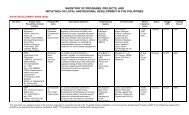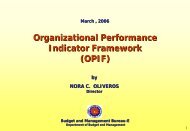rapid assessment of the social impacts of - Philippines Development ...
rapid assessment of the social impacts of - Philippines Development ...
rapid assessment of the social impacts of - Philippines Development ...
Create successful ePaper yourself
Turn your PDF publications into a flip-book with our unique Google optimized e-Paper software.
participation in <strong>the</strong> training is limited to a certain number <strong>of</strong> participants and not everyone who<br />
completed <strong>the</strong> training is able to find a job.<br />
Credit opportunities abound in SV4. Most <strong>of</strong> those who have small enterprises borrow from<br />
“lending” organizations and “5-6.” 8 Those who cannot access credit, such as <strong>the</strong> elderly and<br />
those with irregular employment, turn to <strong>the</strong>ir neighbors, who also charge interest for loans.<br />
SV4 is under <strong>the</strong> jurisdiction <strong>of</strong> two barangays, Caingin and Pooc, an arrangement that creates<br />
difficulties in <strong>the</strong> delivery <strong>of</strong> basic services as it is unclear which barangay is responsible for<br />
what services. The NHA-supervised HOA manages SV4. It consists <strong>of</strong> twelve elected <strong>of</strong>ficials<br />
drawn from <strong>the</strong> roster <strong>of</strong> thirty-five leaders, with each leader representing a residential cluster<br />
<strong>of</strong> one hundred households. SV4 has its own set <strong>of</strong> barangay tanod (community police, all <strong>of</strong><br />
which are men) and barangay health workers (BHWs, all women).<br />
Malaban, Biñan, Laguna. Malaban is one <strong>of</strong> <strong>the</strong> densely populated barangays in Biñan. In 2008,<br />
it had 41,404 residents in 8,281 households, with each household having an average <strong>of</strong> five to<br />
six members. In some cases, as many as three to four families share a housing unit. It has one<br />
health center, an elementary school, a high school and seven pre-schools and day care centers.<br />
Shoemaking is <strong>the</strong> primary occupation <strong>of</strong> <strong>the</strong> residents. When cheaper footwear from China hit<br />
<strong>the</strong> Philippine market, <strong>the</strong> demand for Biñan-made footwear lessened. Shoemakers <strong>the</strong>n<br />
focused on making slippers, and workers in shoe factories shifted to o<strong>the</strong>r occupations, such as<br />
driving tricycles, doing construction work, helping out in <strong>the</strong> wet market, and lakeside fishing.<br />
O<strong>the</strong>rs (both men and women) tried <strong>the</strong>ir luck abroad as contract workers. Some households<br />
rely on vegetable farming along <strong>the</strong> side <strong>of</strong> <strong>the</strong> lake. Women usually sell <strong>the</strong> produce in Biñan<br />
market. Still a number <strong>of</strong> residents, usually men, go to <strong>the</strong> municipality <strong>of</strong> Liliw, considered “<strong>the</strong><br />
slippers capital <strong>of</strong> <strong>the</strong> <strong>Philippines</strong>”, to work as “maglalapat” (shoe factory workers). Those who<br />
engage in fishing are ei<strong>the</strong>r “pante” (fish pen) operators or hook-and-line fishers.<br />
Because it has an extensive wet market that carries wholesale <strong>of</strong>fers <strong>of</strong> meat, vegetable and fish<br />
products, Biñan is able to attract buyers and traders from nearby Sta. Rosa City and <strong>the</strong> town <strong>of</strong><br />
San Pedro. Consequently, selling meat, vegetables and fish products, providing market labor,<br />
and driving transport public vehicles have become <strong>the</strong> main occupations for <strong>the</strong> people <strong>of</strong><br />
Malaban. As a result, more and more families have sought to establish residence in <strong>the</strong> barangay<br />
as renters or informal settlers. Likewise, <strong>the</strong> number <strong>of</strong> people selling vegetables and fish and<br />
operating sari-sari stores has ballooned. Barangay <strong>of</strong>ficials are reportedly only present during<br />
barangay meetings and required <strong>of</strong>ficial functions. According to <strong>the</strong> residents <strong>the</strong>y have not<br />
been very active in carrying out <strong>the</strong>ir tasks in <strong>the</strong> barangay. POs come and go, especially in Zone<br />
7. Often short-lived, <strong>the</strong>se POs are ei<strong>the</strong>r created because a project is being implemented in <strong>the</strong><br />
barangay or because membership in a PO is a requisite for accessing loans. These projects<br />
mostly focus on medical assistance, especially for children. O<strong>the</strong>r POs assist in <strong>the</strong> <strong>social</strong><br />
immersion activities in marginalized communities that Metro Manila-based colleges and<br />
universities organize for <strong>the</strong>ir students.<br />
Control Community<br />
Marikina Heights, Marikina City. Barangay Marikina Heights was established in April 1978<br />
through a Presidential Decree signed by <strong>the</strong>n President Ferdinand Marcos. The natural high<br />
terrain <strong>of</strong> <strong>the</strong> land and its structure made it a likely choice for a control group in this <strong>rapid</strong><br />
<strong>assessment</strong>. The only area in <strong>the</strong> barangay that was briefly flooded was a small portion <strong>of</strong><br />
Champaca at Apitong Street which is situated near <strong>the</strong> creek. To date, <strong>the</strong>re are seven purok<br />
(sub-villages) in <strong>the</strong> barangay with a population <strong>of</strong> almost forty-eight thousand individuals in<br />
14




